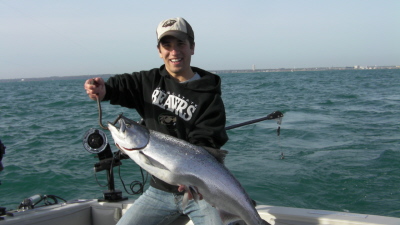Fishing Diving Planers
By Wisconsin fishing charter Capt. Jim Hirt
Most boats run diving planers like Dipsy Divers, Slide Divers, Deep Sixes and similar divers. This is a very simple tool that is not run to its full potential by most fishermen. Here’s how and when. Should you have a question please e-mail me from my Website contact us page. Read all my articles and see video fish reports at http://www.jimhirt.com
The Arsenal
In the last article we covered some of the many ways to use a downrigger. Let us continue with rigging presentation. The tools out there are endless. It is a fisherman with a full arsenal of presentations that finds action when fishing gets tough. It is my experience that on any given day one presentation will produce better than the others.
Diving Planer Types
Most boats run diving planers like Dipsy Divers, Slide Divers, Deep Sixes and similar divers. This is a very simple tool that is not run to its full potential by most fishermen.
The set up
Start with a clear mono or fluorocarbon 25-pound line one and a half times the length of the rod you are using. On one end tie a size 5 cross lock snap to attach the lure. Tie the other end to a snubber.
Snubber or not to Snubber?
Definitely use a snubber. They come in many colors. I prefer a clear product made by Opti-Dodger. The snubber will absorb the shock of the strike and set the hook. The snubber is then attached to the diver.
What line to run with divers
On the release side of the diver tie your line from the rod. You can use a variety of different lines. The standard set up is 20 to 30 pound mono. Some other options are 50-pound Spider Wire Super Braid and stranded wire. The benefits of these options are the smaller diameter of this product allows the diver to reach greater depths.
Rod type is important
An 8 to 10 foot medium heavy action rod with a line counter reel completes this rig. They are often called poor man’s downrigger. When asked by beginning trollers on what to buy I always recommend two diver rigs. One for port one for starboard.
Pros and cons of divers
They will take lures to a prescribed depth and repeat it over and over again. The disadvantage to this rig is it does not have a release and offers some resistance when reeling in fish.
How deep are they running?
All divers come with a sheet of paper to tell you how many feet of line to let out to attain the depth you wish to fish. There is also a base plate adjustment to make the diver go to the left or right side of the boat out of the boat’s path. When fishing calm days in clear water divers offer a stealth presentation. Line counter reels give you total control of depth for repeatability. For those who do not have line counters I would measure the distance from the reel to the first eye on your rod. When setting lines pull line from the reel to the first eye. If it is 2 feet multiply the number of pulls by 2 to calculate your amount of line out. Then refer to diver depth chart to figure diver depth.
One more Option Flat lines
To finish this article I will discuss flat lining. In this presentation you troll free lines off the back of the stern with little or no weight. You are restricted to one or two lines to avoid tangles. The advantage is to spot lures far from the boat 50 to 300 feet back. This is deadly when temperature of the water for your target is right on the surface. Spooky fish like Rainbows and Brown Trout will hit midday on flat lines. My flat line rods are spooled with 12-pound test line or you may use a small barrel swivel and a 12-pound leader to your heavier downrigger line. Use a good quality size 7 cross lock snap swivel to attach your lure. To add a little depth to this presentation use a bead chain keel sinker from 3/8 to 2 ounces eight feet ahead of the snap.
Badger Tackle has a promotion for a free spoon.
Call me anytime to help with your spoon selection. If you would like to try the hottest spoons for salmon and trout for shore anglers or trolling and jigging in 2011 go to http://www.badgertackle.com Good luck. Jim charters out of Milwaukee, WI. with Blue Max Charters. He can be reached at 414-828-1094 or visit his web site at http://www.bluemaxcharters.com Copyright© 2012, James J. Hirt, All Rights Reserved.






